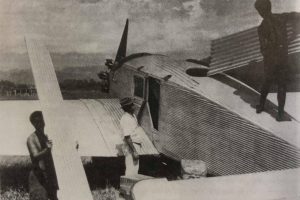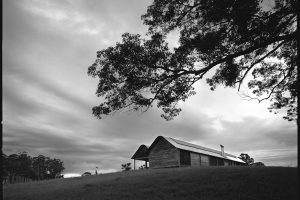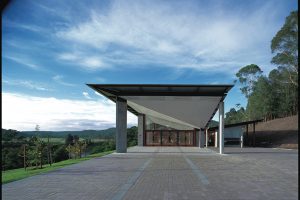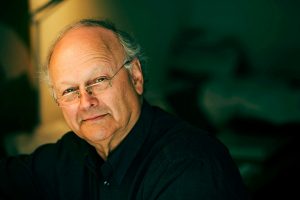PIONEER OF AN AUSTRALIAN ARCHITECTURAL FORM
Thank you very much for inviting me here. It’ s really the Ambassador, Miles Kupa and also the BHP Steel Building Products and other organisations that make it possible For me to come here. My lecture today is very much directed to the students of this country, because we as architects who have practiced for so many years have shown our intent. My real message is to students, where the future lies. A great sense of responsibility must be carried into the future by students, who will be, tomorrow, our architects.
One of the things that I have pursued over my career is a practice where I had spent almost the whole time alone. I have not had a single member of staff. So that ought to tell all of you students that I don’ t employ. So I must tell you, please don’ t write and ask me for a job because I don’ t have one. I work absolutely alone, and the beauty of that is it has given me time. The luxury of time to think, then to sit and understand where I am, for whom I’m designing, the size, the place. An architecture I have attempted of place, whether it’ s the monsoon or the tropic, the hot, arid, the temperate, warm temperate, subtropical or tropical. All these different climates have directed for me a way of designing. You will see that the buildings I show you are non air-conditioned buildings. They are all climate-conditioned buildings. That’ s been very important to the way I think.

Maison de Verre
The other thing that I want to mention to you is this – that drawing by hand is critical. My very close friend from Finland and I have spoken for many years about the importance of the mind-eye-hand connection. The computer doesn’t dwell in the same connection. In drawing, feeling through drawing, and knowledge through drawing, in my view, is paramount. And to university representatives here, I recommend to you, at least with the computer in parallel, they are after all a tool only, that the students also learn to draw, and to keep drawing as an activity going. Because designing without drawing is a denial of a limb of our body. It’ s an access to our mind, and it’ s just been shown in the last few months by a professor at Massachusetts Institute of Technology in the United States, who is in the Department of Philosophy, where he has done experiments using ECG’ s to be able to measure the way of thinking and how thinking can be so different as a conceptual idea to the hand, to the mouse. And it’ s the hand that shows the great level of thinking, together with abstract thinking of the mind. And so the computer is a tool, an important tool. I use the computer for letters. I don’t use it for drawing because I prefer to draw by hand. I can still beat most people on computers by drawing by hand with the sort of work I do. So in my practice, I do everything, from meeting clients, designing the buildings, visiting sites, doing the drawings, the full circle. I don’ t break it into little pieces. And unless you as architects and student architects of the future are actually able to be on site, and work on site with builders, so that you work with and not against builders, so that you understand the process of construction… I’ve learned this week that you, in your country, are absolute masters at buildings that are representative of our future through your past. Your historic buildings are very much power for the future in terms of the ecological responses that are required by all of us as architects, because you knew how to put buildings together in a way that you can pull them apart and reuse every place of material. Nothing ’s lost. That is our future. And unless we understand that buildings are going to be pulled apart, and unless we understand that materials have to be reused, then we are not, in my view, of the future. I believe the time is coming where every question will have to be addressed as an ecological issue. How do we do something, do we go this way or that way? We‘re going to think about how we do it, using, as part of the questions and answers, the ecological issues.
Now I want to stress the idea about drawing because I go around the world today and see students that are pretending to design, that are not designing in the way they ought to. I teach at Yale, I teach at St. Louis, I teach at Ann Arbor, I teach at UCLA, I teach in Australia, and I practice. And so I’ m getting a great breadth of understanding of what’ s happening internationally. And the computers have taken a role far more importantly than they ought to have.

Photo from Touch This Earth Lightly: Glenn Murcutt in His Own Words
ผมขอขอบคุณมากๆ ที่ให้เกียรติเชิญผมมาที่นี่ ท่านเอกอัครราชทูต Miles Kupa, BHP Steel Building Products และอีกหลายองค์กรที่ช่วยกันจัดงานบรรยายของผมที่นี่ สิ่งที่ผมจะพูดในวันนี้จะเกี่ยวข้องโดยตรงกับนักศึกษาของประเทศนี้ เนื่องจากพวกเราทุกคนที่ประกอบอาชีพสถาปนิกกันมาเป็นเวลายาวนานหลายปีได้แสดงเจตจำนงของเราไปแล้ว สิ่งที่ผมพูดจึงเป็นสาระสำหรับคนรุ่นใหม่ซึ่งจะเป็นผู้กำหนดอนาคตต่อไป โดยภาระหน้าที่ความรับผิดชอบอันภายภาคหน้าจะต้องถูกดำเนินต่อไป โดยนักศึกษาผู้กำลังจะเป็นสถาปนิกในวันพรุ่งนี้
สิ่งหนึ่งที่ผมอยากจะพูดถึงเกี่ยวกับการทำงานของผมคือ ผมทำงานเพียงคนเดียว ไม่มีลูกน้อง หรือผู้ร่วมงานเลยสักคนเดียว ดังนั้นจงอย่าเขียนจดหมายมาสมัครงานกับผม เพราะผมไม่จ้างใคร ผมทำงานโดยลำพัง ข้อดีของมันก็คือ มันทำให้ผมมีเวลาเหลือเพื่อที่จะคิดและทำความเข้าใจตัวเอง คนที่ผมกำลังจะออกแบบให้ขนาด สถานที่ตั้ง และสภาพภูมิอากาศของที่ที่สถาปัตยกรรมจะต้องตั้งอยู่ ว่ามันอยู่ในเขตมรสุม หรือเขตร้อนชื้น ร้อนแห้ง และมีอุณหภูมิเป็นอย่างไร สภาพภูมิอากาศที่แตกต่างกันเหล่านี้เป็นตัวกำหนดแนวทางในการออกแบบของผม คุณจะเห็นว่าอาคารหลายหลังที่ผมนำมาให้ชมในวันนี้เป็นอาคารที่ไม่มีระบบปรับอากาศซึ่งมีความสำคัญต่อแนวคิดของผมเป็นอย่างมาก
อีกเรื่องหนึ่งที่อยากจะบอกพวกคุณนั่นคือ การเขียนลายเส้นด้วยมือมีความสำคัญมาก เพื่อนสนิทคนหนึ่งจากฟินแลนด์ และตัวผมเองเพียรพูดถึงเรื่องความสัมพันธ์ของ ใจ – ตา – มือ กันมาหลายปี คอมพิวเตอร์ไม่สามารถสร้างความสัมพันธ์แบบนี้ได้ ในการเขียนลายเส้นนั้น ผมมีความเห็นว่า ความรู้สึกขณะที่ลากเส้นและความรู้ที่เกิดขณะนั้นมีความยิ่งใหญ่ และสำหรับตัวแทนจากมหาวิทยาลัยที่อยู่ที่นี่ทุกคน ผมอยากจะแนะนำว่านักศึกษาควรจะได้เรียนรู้ที่จะเขียนลายเส้นด้วยมือควบคู่ไปกับการใช้คอมพิวเตอร์เพราะว่าการออกแบบโดยปราศจากการเขียนลายเส้นก็คือการปฏิเสธแขนขาของเราเอง มันเป็นเส้นทางเข้าไปสู่ภายในใจเรา เรื่องนี้เคยมีการแสดงผลการศึกษาไปเมื่อไม่กี่เดือนก่อน โดยอาจารย์ที่ Massachusetts Institute of Technology ในสหรัฐในคณะปรัชญาซึ่งเขาได้ทำการทดลองใช้ ECG’ s ในการจัดวิธีคิด และความแตกต่างทางความคิดระหว่าง conceptual idea จากการใช้มือ และการใช้ mouse ผลปรากฏว่าการใช้มือแสดงระดับความคิดที่สูงกว่า รวมทั้งมีความคิดเชิงนามธรรมของจิตใจด้วย ผมใช้คอมพิวเตอร์เขียนจดหมาย ผมไม่ใช้มันสร้างลายเส้น เพราะผมชอบเขียนด้วยมือ ผมสามารถเอาชนะคนที่ใช้คอมพิวเตอร์ส่วนใหญ่ด้วยการเขียนด้วยมือ ดูได้จากงานของผมในการทำงานผมทำทุกอย่างตั้งแต่พบลูกค้า ออกแบบอาคาร ไปดูไซต์งาน รวมทั้งเขียนลายเส้นเองครบวงจรเลย ผมไม่แบ่งงานออกเป็นส่วนๆ และถ้าคุณซึ่งเป็นสถาปนิกหรือนักศึกษาผู้ที่จะเป็นสถาปนิกในอนาคตไม่สามารถจะไปที่ไซต์งาน และทำงานร่วมกับนายช่างคุณก็จะไม่สามารถเข้าใจกระบวนการในการก่อสร้างทั้งหมดได้ สิ่งที่ผมได้เรียนรู้ในช่วงสัปดาห์นี้ คือ คนในประเทศนี้มีความเก่งกาจในเรื่องของการสร้างอาคารที่มีวิสัยทัศน์ทอดยาวไปถึงอนาคต อันดูได้จากอาคารในอดีตของพวกคุณ อาคารของพวกคุณให้ความสำคัญต่อระบบนิเวศน์ ซึ่งมีความจำเป็นที่พวกเราสถาปนิกทุกคนจะต้องเรียนรู้เพราะคุณรู้ว่าจะวางอาคารเหล่านี้ร่วมกันอย่างไร โดยที่สามารถแยกออกจากกันได้ และยังนำวัสดุกลับมาใช้ใหม่ได้ทุกชิ้น ไม่มีการสูญเสียนั่นคืออนาคตของเรา และถ้าไม่เข้าใจว่าวัสดุต้องถูกนำกลับมาใช้ใหม่ ผมคิดว่าพวกเราก็ไม่ใช่คนในอนาคต ผมเชื่อว่ามันถึงเวลาแล้วที่ทุกๆ ปัญหาจะต้องมุ่งไปสู่ประเด็นเรื่องของระบบนิเวศไม่ทางใดก็ทางหนึ่ง
ตอนนี้ผมอยากจะเน้นเกี่ยวกับการวาดเส้นเพราะว่าผมเห็นนักศึกษาทุกวันนี้ทำทีเป็นนักออกแบบทั้งๆ ที่มันไม่ใช่การออกแบบอย่างที่มันควรจะเป็น ผมสอนที่ Yale ผมสอนที่ St. Louis ผมสอนที่ Ann Arbor ผมสอนที่ UCLA ผมสอนที่ออสเตรเลีย และยังทำงานเป็นสถาปนิกด้วย มันทำให้ได้รู้เห็นสิ่งที่เกิดขึ้นในระดับสากล และคอมพิวเตอร์มีบทบาทสำคัญมากเกินไปกว่าที่มันควรจะเป็น
FIRST PUBLISHED IN ART4D VOL.80 MARCH 2002
Edited and translated from Glenn Murcutt’s lecture in Bangkok on November 3, 2001
Special thanks to the Australian Embassy in Thailand and BHP Steel Building Products (Thailand)
Cover photo by Skyline Studio
READ MORE ABOUT GLENN MURCUTT





